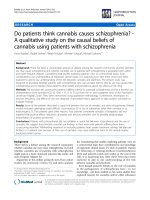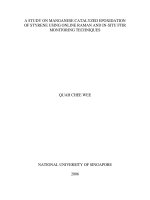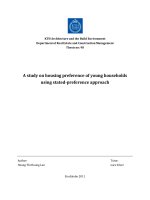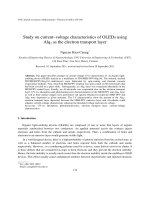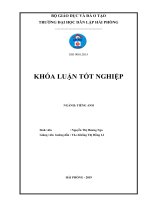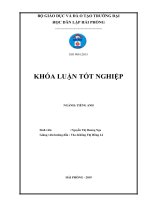Study on extract loaded cashew nut testa using different emulsifiers by double nanoemulsion method
Bạn đang xem bản rút gọn của tài liệu. Xem và tải ngay bản đầy đủ của tài liệu tại đây (1.02 MB, 83 trang )
HO CHI MINH NATIONAL UNIVERSITY
HO CHI MINH UNIVERSITY OF TECHNOLOGY
HUYNH LE THANH PHUC
STUDY ON EXTRACT – LOADED CASHEW NUT TESTA
USING DIFFERENT EMULSIFIERS BY DOUBLE
NANOEMULSION METHOD
Major: Food Technology
Major Code: 8540101
MASTER THESIS
HO CHI MINH CITY, July 2023
THIS THESIS IS COMPLETED AT
HO CHI MINH CITY UNIVERSITY OF TECHNOLOGY – VNU-HCM
Supervisor: Assoc. Prof. Nguyen Thi Lan Phi
Examiner 1: Assoc. Prof. Nguyen Vu Hong Ha
Examiner 2: Assoc. Prof. Mai Huynh Cang
This master’s thesis is defended at HCM City University of Technology, VNU- HCM City
on July 14th , 2023
Master’s Thesis Committee:
1. Chairman: Assoc. Prof. Phan Ngoc Hoa
2. Examiner 1: Assoc. Prof. Nguyen Vu Hong Ha
3. Examiner 2: Assoc. Prof. Mai Huynh Cang
4. Council Member: Assoc. Prof. Nguyen Thi Lan Phi
5. Secretary: Assoc. Prof. Tran Thi Thu Tra
Approval of the Chair of Master’s Thesis Committee and Dean of Faculty of Chemical
Engineering after the thesis being corrected (If any).
CHAIRMAN OF THESIS COMMITTEE
DEAN OF FACULTY OF
CHEMICAL ENGINEERING
ii
VIETNAM NATIONAL UNIVERSITY - HO CHI MINH CITY
HO CHI MINH UNIVERSITY OF TECHNOLOGY
SOCIALIST REPUBLIC OF VIET NAM
Independent – Liberty - Happiness
THE TASK SHEET OF MASTER’S THESIS
Student’s name: HUYNH LE THANH PHUC ......................... Student ID: 2170459
Date of birth: March 3rd, 1998 ................................................... Place of Birth: HCM City
Major: Food Technology ........................................................... Major ID : 8540101
I.
THESIS TITLE (In Vietnamese):
Nghiên cứu vi bao dịch chiết vỏ lụa hạt điều bằng phương pháp tạo nhũ nano kép sử dụng
các chất mang khác nhau.
II.
THESIS TITLE (In English):
Study on extract-loaded cashew nut testa using different emulsifiers by double nanoemulsion method.
III. TASKS AND CONTENT:
- Analysis of total content of Phenolic, Flavonoid, Catechin compounds and antioxidant
capacity of cashew nut testa extract.
- Investigation of encapsulation conditions of bioactive compounds in cashew nut testa
extract by double emulsion method with different emulsifiers.
- Investigation of the stability of the emulsion system of cashew nut testa extract.
IV. THESIS START DAY: February 2nd, 2023
V.
THESIS COMPLETION DAY: June 6th , 2023
VI. SUPERVISOR : Assoc. Prof. Nguyen Thi Lan Phi
Ho Chi Minh City, date…
SUPERVISOR
HEAD OF FOOD TECHNOLOGY DEPARTMENT
HEAD OF CHEMICAL ENGINEERING DEPARTMENT
iii
ACKNOWLEDGMENT
This thesis is done in Central Experimental Laboratory of Ho Chi Minh City University of
Food Industry (HUFI) and Laboratory of Food Processing and Technology B2 of Ho Chi
Minh University of Technology (HCMUT) under the instruction of Associate Professor.
Nguyen Thi Lan Phi.
To accomplish this thesis, in addition to my own efforts, I have received a lot of support
from my supervisors and friends. I would like to express my sincere thanks to everyone
who accompanies and helps me.
At first, I would like to thank my dear family, I would like to especially express profound
love to my parents and brother – who always stand behind and encourage me.
Secondly, I would like to express my sincere gratitude to Associate Professor. Nguyen Thi
Lan Phi and Professor Pham Van Hung. Not only has they instructed and given precious
advices to me in order to deal with the experimental difficulties and calculations but they
also supported favorable conditions as well as chemicals during our thesis.
Also, I am very grateful for the helping of MSc. Hoang Van Thanh and MSc. Truong Thanh
An of Central Experimental Laboratory, Msc. Mai Nguyen Tram Anh of International
University and PhD. Tran Thi Tuong An of Laboratory of Food Processing and Technology
B2 for supporting the necessary experimental instruments, chemicals and creating
comfortable environment as well as giving suitable suggestions during the implement of
my thesis.
Thank you, all friends who work together in the Central Experimental Laboratory and
Laboratory of Food Processing and Technology in the process of implementing the thesis.
Eventually, I would like to express sincere thanks to the anyone who always motivates and
sympathizes with me.
i
ABSTRACT
The bioactive compounds in cashew nut testa has many functional benefits for human
health which can be applied in food industry as well as needing to be effectively preserved.
In the study, the enzyme and ultrasonic - assisted (E-UAE) cashew nut testa extract was
emulsified in the 𝑊1 /𝑂/𝑊2 system which uses Lecithin as lipophilic and Tween 80, Whey
protein Isolate (WPI) as hydrophilic emulsifiers. Furthermore, some ratios of components
in the system are investigated in order to choose the best ratios as well as investigating the
stability of the emulsion in 28 days at room temperature.
The cashew nut testa extract has total phenolic content (TPC) is 123.06 ± 0.45 (mg
GAE/ g DW sample), total flavonoid content (TFC) is 100.41 ± 0.08 (mg CAT/g DW
sample), total catechin content is 22.13 ± 0.41 (mg CAT/ g DW sample) and the
antioxidant capacity is 1.08 ± 0.02 (mmol TE/ g DW sample).
The results show the best conditions of the emulsification which include 𝑊1 : 𝑂 ratio,
Lecithin content, 𝑊2 : 𝑊1 /𝑂 ratio, Tween : WPI ratio are 10 : 90 (w/w), 3 % (w/w), 80 :
20 (w/w) and 2 : 3 (w/w), respectively. The double nanoemulsion has the encapsulation
efficiency (EE) is 91.37 ± 2.48 %, the droplet size is 267.2 ± 2.8 nm, the polydispered
index is 0.228 ± 0.007 and the Zeta value is −62.0 ± 0.6.
The stability of the double emulsion is also investigated which has encapsulation
efficiency is 21.40 ± 1.79 %, droplet size is 257.6 ± 1.4 nm, Polydispered Index is
0.303 ± 0.026 and the Zeta value is −69.4 ± 1.8 after 28 days storage at room
temperature.
From the results, it can be show the ability of double nanoemulsion systems in the
protection of the internal bioactive compounds of cashew nut testa which can be potentially
applied in the food industry.
ii
TĨM TẮT
Các hợp chất có hoạt tính sinh học trong vỏ hạt điều có nhiều cơng dụng hữu ích đối
với sức khỏe con người, có thể ứng dụng trong cơng nghiệp thực phẩm cũng như cần được
bảo quản hiệu quả. Trong nghiên cứu, chiết xuất vỏ lụa hạt điều có sự hỗ trợ của enzyme
và sóng siêu âm (E-UAE) được nhũ hóa trong hệ nhũ tương nano kép 𝑊1 /𝑂/𝑊2 sử dụng
Lecithin làm chất nhũ hóa ưa béo và Tween 80, Whey protein Isolate (WPI) làm chất nhũ
hóa ưa nước . Ngoài ra, một số tỷ lệ thành phần trong hệ nhũ tương cũng được khảo sát
nhằm lựa chọn tỷ lệ tốt nhất cũng như khảo sát độ ổn định của hệ nhũ tương trong 28 ngày
ở nhiệt độ phòng.
Dịch chiết vỏ lụa hạt điều có hàm lượng phenolic tổng (TPC) là 123,06 ± 0,45 (mg
GAE/g chất khô), hàm lượng flavonoid tổng (TFC) là 100,41 ± 0,08 (mg CAT/g chất khô),
hàm lượng catechin tổng là 22,13 ± 0,41 (mg CAT/g chất khơ) và khả năng chống oxy hóa
là 1,08 ± 0,02 (mmol TE/g chất khô).
Kết quả cho thấy tỷ lệ thành phần tốt nhất của q trình nhũ hóa bao gồm tỷ lệ 𝑊1 : 𝑂,
hàm lượng Lecithin, tỷ lệ 𝑊2 : 𝑊1 /𝑂, tỷ lệ Tween : WPI lần lượt là 10 : 90 (w/w), 3 %
(w/w), 80 : 20 (w/w) và 2 : 3 (w/w), tương ứng. Nhũ tương nano kép tốt nhất có hiệu suất
bao bọc (EE) là 91,37 ± 2,48 %, kích thước giọt là 267,2 ± 2,8 nm, chỉ số polydispered là
0,228 ± 0,007 và giá trị Zeta là -62,0 ± 0,6.
Độ ổn định của nhũ tương kép tốt nhất cũng được nghiên cứu với hiệu suất bao bọc là
21,40 ± 1,79 %, kích thước giọt là 257,6 ± 1,4 nm, Chỉ số đa phân tán là 0,303 ± 0,026 và
giá trị Zeta là -69,4 ± 1,8 sau 28 ngày bảo quản ở nhiệt độ phịng .
Từ kết quả thu được, có thể cho thấy khả năng của hệ nhũ tương nano kép trong việc
bảo vệ các hợp chất có hoạt tính sinh học bên trong vỏ hạt điều và cho thấy tiềm năng trong
việc ứng dụng trong công nghiệp thực phẩm.
iii
COMMITMENT
I hereby declare that this is my own independent scientific work. The results in this study
do not reproduce or infringe the copyright of any other source. The reference to the
document has been cited and the source of the reference is recorded in accordance with
regulations.
Student
iv
CONTENTS
ACKNOWLEDGMENT .................................................................................................... i
ABSTRACT ....................................................................................................................... ii
TÓM TẮT ......................................................................................................................... iii
COMMITMENT .............................................................................................................. iv
CONTENTS ....................................................................................................................... v
LIST OF FIGURES ........................................................................................................ viii
LIST OF TABLES ............................................................................................................ ix
LIST OF ABBREVIATIONS ........................................................................................... x
CHAPTER 1: INTRODUCTION .................................................................................... 1
CHAPTER 2: LITERATURE REVIEW ........................................................................ 2
2.1. Anacardium genus ................................................................................................... 2
2.1.1. Classification and distribution .................................................................. 2
2.1.2. Production of cashew nut in the world and Vietnam .............................. 3
2.2. Cashew nut ............................................................................................................... 4
2.2.1. Description .................................................................................................. 4
2.2.2. Chemical composition ................................................................................ 5
2.3. Cashew nut testa ...................................................................................................... 6
2.3.1. Chemical compositions............................................................................... 6
2.3.2. Phenolic compounds in cashew nut testa ................................................. 7
2.3.3. Extraction methods .................................................................................... 8
2.3.4. Bioactivity potentials of cashew nut testa .............................................. 11
2.4. Double nanoemulsions and other types ............................................................... 13
2.4.1. Definition ................................................................................................... 13
2.4.2. Preparation ............................................................................................... 15
2.4.3. High – energy methods............................................................................. 18
2.4.4. Emulsifiers ................................................................................................ 19
v
2.4.5. Droplet size, Polydispersity index and Zeta – potential ........................ 22
2.4.6. Practical Studies ....................................................................................... 23
CHAPTER 3: MATERIAL AND METHODS ............................................................. 25
3.1. Materials and chemicals ....................................................................................... 25
3.2. Intrustments........................................................................................................... 26
3.3. Material Preparation ............................................................................................ 26
3.4. Extraction of Cashew nut Testa ........................................................................... 27
3.5. Preparation of Double Nanoemulsion 𝑾𝟏/𝑶/𝑾𝟐 ............................................ 28
3.6. Investigating the components of Double Nanoemulsion 𝑾𝟏/𝑶/𝑾𝟐 ............... 30
3.6.1. Investigation of 𝑾𝟏: 𝑶 ratio .................................................................... 30
3.6.2. Investigation of Lecithin content............................................................. 31
3.6.3. Investigation of 𝑾𝟐 : 𝑾𝟏/𝑶 ratio .......................................................... 31
3.6.4. Investigation of Tween 80 : WPI ratio ................................................... 31
3.7. Determination of Total Phenolic content (TPC) ................................................ 31
3.8. Determination of Total Flavonoid content (TFC) .............................................. 32
3.9. Determination of Total Catechin content (TCC) ............................................... 32
3.10. Determination of DPPH radical scavenging assay ........................................... 33
3.11. Determination of Encapsulation Efficiency ...................................................... 33
3.12. Determination of Droplet Size, Polydisperity Index and Zeta Potential ....... 34
3.13. Determination of Stablity of double nanoemulsion ......................................... 34
3.14. Statistical Analysis .............................................................................................. 34
CHAPTER 4: RESULTS AND DISCUSSION ............................................................. 35
4.1. Polyphenol compounds content in cashew nut testa .......................................... 35
4.2. Investigating the components of Double Nanoemulsion 𝑾𝟏/𝑶/𝑾𝟐 ............... 36
4.2.1. Investigation of 𝑾𝟏: 𝑶 ratio .................................................................... 36
4.2.2. Investigation of Lecithin content............................................................. 38
4.2.3. Investigation of 𝑾𝟐 : 𝑾𝟏/𝑶 ratio .......................................................... 40
4.2.4. Investigation of Tween 80 : WPI ratio ................................................... 41
4.3. Determination of Stablity of double nanoemulsion ........................................... 42
CHAPTER 5: CONCLUSION AND RECOMMENDATION .................................... 44
vi
5.1. Conclusion .............................................................................................................. 44
5.2. Recommendation ................................................................................................... 45
REFERENCES ............................................................................................................. 46
APPENDIX A: ANALYTICAL METHODS ............................................................ 60
APPENDIX B: ANALYTICAL RESULTS. .............................................................. 63
APPENDIX C: SAMPLE PICTURES ....................................................................... 69
vii
LIST OF FIGURES
Figure 2.1. Cashew tree and their fruit. ............................................................................... 2
Figure 2.2. The column chart of global cashewnut yield from 2010 – 2020. ..................... 3
Figure 2.3. Cashew nut cross – section. .............................................................................. 4
Figure 2.4. Cashew nut testa. ............................................................................................... 6
Figure 2.5.Comparison between 3 types of emulsions. ..................................................... 15
Figure 2.6. Schematic illustration of high and low – energy emulsification methods. ..... 17
Figure 2.7. Schematic illustration of cross – flow (left) and pre – mix (right) membrane
emulsification methods. ..................................................................................................... 17
Figure 3.1. Sample preparation process ............................................................................ 26
Figure 3.2. Cashew nut testa enzymatic extraction process. ............................................. 27
Figure 3.3. Cashew nut testa double emulsion preparation process. ................................. 29
viii
LIST OF TABLES
Table 2.1. Major components in cashew nut. ...................................................................... 5
Table 2.2. Major chemical components in cashew nut testa. .............................................. 7
Table 3.1. List of experimental intrustments ..................................................................... 25
Table 4.1. Chemical parameters of Cashew nut testa. ....................................................... 35
Table 4.2. Encapsulation efficiency and physical parameters of double nanoemulsions at
different 𝑊1: 𝑂 Ratios. ...................................................................................................... 37
Table 4.3. Encapsulation efficiency and physical parameters of double nanoemulsions at
different Lecithin concentrations. ...................................................................................... 38
Table 4.4. Encapsulation efficiency and physical parameters of double nanoemulsions at
different 𝑊2 : 𝑊1/𝑂 ratios............................................................................................... 40
Table 4.5. Encapsulation efficiency and physical parameters of double nanoemulsions at
different Tween 80 : WPI ratios. ....................................................................................... 41
Table 4.6. Effect of storage time on the EE and physical parameters of double
nanoemulsion at room temperature ................................................................................... 43
ix
LIST OF ABBREVIATIONS
E – UAE
Enzyme and ultrasonic assisted – extraction.
UAE
Ultrasonic assisted – extraction.
EAE
Enzymatic assisted – extraction.
WPC
Whey protein concentration.
WPI
Whey protein isolate.
DW
Dry weight.
TPC
Total phenolic content.
TFC
Total flavonoid content.
TCC
Total catechin content.
EE
Encapsulation efficiency.
PDI
Polydispersity Index.
PGPR
Polyglycerol polyricinoleate
GAE
Gallic acid equivalents.
CAT
Catechin equivalents.
TE
Trolox equivalents.
DPPH
2,2-diphenyl-1-picrylhydrazyl.
SET
Single electron transfer.
Z – value
Zeta potential
HR
Conventional heat flux method
DLS
Dynamic light scattering
UV–Vis
Ultra Violet-Visible
x
CHAPTER 1: INTRODUCTION
The cashew nut (Anacardium occidentale) is one the most popular exporting agricultural
commodities in Vietnam. There are many by-products from the cashew nut processing such
as outer hard shell, cashew apple or the cashew nut testa.
The cashew nut testa is a rich source of bioactive compounds such as catechin and
epicatechin which is the primary flavonoids [1]. These bioactive compounds have potential
applications in food or pharmaceutical industry because of their antioxidant, antibacterial or
anticancer activities. However, the testa is only usually used for livestock feeding, leather
production or biomass. So that, the potential of bioactive compounds in the testa are not fully
ultilized.
Emulsification is the method of combining two liquids to create a colloidal suspension, in
which the components of one liquid are dispersed but not dissolved in the other. The method
has many potential in encapsulation of hydrophilic compounds and protected, including
volatile compounds, vitamins, minerals, amino acids and polyphenols to enhance the sensory
qualities of specific goods and cover the odor of particular molecules [2]. This method is
widely applied in many product in food industry such as including milk, cream, coffee
creamer, soft drinks, nutritional beverages, sauces, dips, deserts, dressings, mayonnaise, ice
cream, margarine, and butter [3].
The bioactive compounds are easily impact by the external environment such as
ultraviolet radiation, temperature, climate which have many influences in the amount of
bioactive compounds [4]. So that the emulsification can be a proper method for protection of
these compounds from external environment.
In this study, the cashew nut testa was extracted by the enzyme and ultrasonic – assisted
extraction (E – UAE) then encapsulated the extract by the emulsification. The study aims are
investigated the best ratios of components for the highest encapsulation of bioactive
compounds in the extract as well as investigating the stability of the double nanoemulsion.
1
CHAPTER 2: LITERATURE REVIEW
2.1. Anacardium genus
2.1.1. Classification and distribution
Anacardium is a genus which comes from Anacardiaceae family as well as cashew
family or sunac family. There are about 83 gerena and 860 species have been found around
the world [5] in this family. The most well – known species used in food industry is
Anacardium occidentale or cashew nut.
Anacardium genus has origin from tropical regions in South America like Southern
Honduras to Panama, Brazil, and Eastern Paraguay while Anacardium occidentale may come
from the tropical savanna area in Central Brazil [6]. Nowaday, cashew nut tree is mainly
planted in India, Vietnam, Côte d'Ivoire, Guinea-Bissau, Tanzania, Benin, Brazil and other
countries in East and West Central Africa and South East Asia.
In Vietnam, the cashew tree is mainly
cultivated in Binh Phuoc, Dong Nai, Daklak,
Gia Lai province. In Binh Phuoc, because of
the suitably tropical climate as well as red
basaltic and acrisols soil on ancient alluvium
so this province is the most cultivated in
cashew tree which has planted area is about
170.000 ha in 2020. In details, Bu Dang, Bu
Gia Map, Phu Rieng and Dong Phu districts is
4 area where the tree mainly plant in Binh
Phuoc province. Dong Nai province is the
second most fertilized area for planting cashew
tree which area is 36.000 ha.
2
Figure 2.1. Cashew tree and their fruit.
2.1.2. Production of cashew nut in the world and Vietnam
The global yield of cashew nut product has been fluctuated through the time. As in Figure
2, From 2010 – 2020, the yield is range from 3.18 – 4.41 million tons which highest yield is
in 2015 and the lowest is in the next year. In 2020, the production value is 4.18 million tons
which is increased in comparison of the last year.
Figure 2.2. The column chart of global cashewnut yield from 2010 – 2020.
The main exporters of cashew nut is Ivory Coast, India, Vietnam, Tanzania,Nigeria
Ghana, Burundi, Benin, Mozambique, Madagascar,… According to FAO, in 2020, the
production yield of cashew nut in Viet Nam is 348.504 tons, India is 772.779 tons and the
largest exporter is Ivory Coast which yield is 848.700 ton.
In Vietnam, the cashew is mainly cultivated in Southeast and Central Highlands region
which consist of Binh Phuoc, Dong Nai, Daklak, Gia Lai. According to FAO, in the period
2010 – 2020, the cashew yield is fluctuated from 215.765 – 352.029 tons which reaches the
highest in 2015 and drops significantly in 2017. The export turnover of cashew nut contributes
to Vietnam economy over 3 billion USD in 2020 which main imported market is America,
Netherland, Australia, England, Canada.
3
2.2. Cashew nut
2.2.1. Description
Anacardium occidentale tree has height from 10 – 15 m with short, unbalanced shape
grown on tropical or subtropical regions. The leaves of the cashew tree has leather color,
ellipse or obovate shape and the flower is small, greenish color at first then becomes crimson
when mature.
The cashew fruit has yellow, red or yellowish - red colour when maturity which length is
about 5 – 11 cm. It is also juicy, spongy, fibrous and has astringent taste. At the end of the
fruit has a kidney – shaped nut which kernel covered by a double shell consisted of inner thin
layer (testa or husk) and outside thick layer (nut shell).
Figure 2.3. Cashew nut cross – section [7].
The cashew fruit and nut has independent growth which the former become maximize the
weight after 50 days and the latter is 30 days. Moever, the fruit growth faster after the nut
reaching maximum size and the nut shell also become dehiscent, harden in this time which
make the nut weight reduce about 10 – 40% [8].
The harvesting season of cashew nut depends on geographic location of cultivated
countries. Generally, the harvesting period of cashew nut ranges from February to June or
July. The riped fruits drop from the trees are collected by farmers. Then, the nuts separated
from the fruits and dried by sun heating in 2 – 3 days in order to reduce the moisture content.
Finally, they are stored in suitable conditions for selling to merchants. The remain fruits are
usually ultilized for fertilizer and cattle feeding but sometimes the Indian used for fermentation
to make cashew alcohol (Feni).
4
2.2.2. Chemical composition
The cashew nut is a rich source of fat which includes mono - and polyunsaturated fatty
acids occupy about 75% total lipids. Moreover, the main fatty acid in the nut is oleic acid
which is dominant in the former and linoleic acid in the latter [9]. The carbohydrate content
in the nut is also high which mainly composed of starch, sugar and fiber. Furthermore, the
main sugar in the nut is sucrose which occupied over 98% in total sugar content, the remains
are glucose and fructose according to USDA. The other pretty high amount composition is
protein which the most abundant amino acid is glutamic acid (about 4.6 g/100 g), the following
are Arginine (2.2 g/100 g) and Aspartic acid (1.9 g/100 g) [10].
Table 2.1. Major components in cashew nut [9].
Component
Content (g/100 g)
Moisture
4.39 ± 0.04
Lipid
43.71 ± 1.13
Protein
18.81 ± 0.06
Ash
2.66 ± 0.21
Sugar
3.96 ± 0.08
Cashew nut testa contains many phenolic compounds such as catechin, epicatechin,
epigallocatechin which are dominant, syringic, gallic acid and p-coumaric acid [11] which has
anti-hyperlipidaemic, anti-inflammatory, antioxidative, anticarcinogenic, and cytoprotective
effect for human health.
Furthermore, the cashew nut shell can be extracted to obtain the oil or liquid which main
compounds are anacardic acid which has many bioactive activities such as such as antitumor,
antioxidant, gastro-protective, and antibiotic. Moreover, the heating product of anarcadic acid
create cardanol (60 – 65%) and cardol (15 – 20%) which are main components in the oil [12].
However, these compounds are also allergic factor which cause mouth – burning, pruritic,
reddish - brownish rash on skin prolong about 4 – 5 weeks to the consumers [13].
5
2.3. Cashew nut testa
2.3.1. Chemical compositions
The cashew nut testa or husk is the reddish - brown inner thin layer of the kernel which
occupies 1 – 3% total weight of the whole nut [1]. Usually, they are used for animal feed,
tanning industry, animal feed, fuel burning, fertilizer, compost making,… because of the
remarkable protein and fat content.
In the dry matter of cashew nut testa composed of 190 g/kg crude protein, 103 g/kg crube
fiber, 20.1 g fat and 20.2 g/kg ash [14] which are the high energy source for farming animal
feeding. Moreover, the testa has the acid detergent fiber and neutral detergent fiber contents
which are 14.91 % and 40.23 %, respectively as well as the remarkable hydrolysable tannins
content is about 22.03 % [15].
Figure 2.4. Cashew nut testa.
6
Table 2.2. Major chemical components in cashew nut testa [14].
Component
Content (g/kg)
Moisture
905
Protein
190
Crude Fiber
103
Ether extract
20.1
Ash
20.2
Calcium
5.6
Phosphorus
1.9
Potassium
1.5
Magnesium
5.8
Metabolizable energy (MJ kg −1 )2
7.12
2.3.2. Phenolic compounds in cashew nut testa
There are many kind of phenolic compounds in the cashew testa but the most notable
group is Flavan-3-ols (the subclass flavanols) which is found in many foodstuff under many
structural types such as monomer (catechin and epicatechin), oligomers, polymers
(proanthocyanidins), and other derivative compounds (such as theaflavins and thearubigins)
[16]. The structure of the group is C15 (C6-C3-C6) structure which consist of benzopyran
sub-group (A and C rings) combined with aromatic ring (B ring) linked to carbon C-2 of C
ring.
In the study of (Chandrasekara and Shahidi, 2011) [11], the raw defatted cashew nut testa
samples were investigated for analysing total phenolic compounds (TPC) which resulted in
soluble phenolics and bound phenolics are 269.05 ± 9.77 GAE mg/g and 1.36 ± 0.1 GAE mg/g
respectively. Moreover, the phenolic profile of the testa consisted of catechin, epicatechin,
7
epigallocatechin, syringic acid, p – coumaric acid, gallic acid which catechin was the most
dominant compound.
According to the study of (Trox et al.,2011) [17], the dry matter of cashew nut testa sample
were analysed by using RP – HPLC, LC – MS methods which results revealed the significant
amount of catechin and epicatechin in the testa are 5.7 and 4.46 g/kg dry matter, respectively.
The other study of (Matthew and Parpia, 1970) [1] showed that catechin and epicatechin
content in the testa were 6 % and 7.5 % in dry samples correspondingly and contributed over
40 % total polyphenols. Furthermore, the polymer proanthocyadinidins occupied less than 40
% and the monomeric proanthocyadinins structure consists of 2 leucocyanidins and 2
leucopelargonidin. Leucocyadinin was the majority leucoanthocyadinin.
In the cashew nut testa, the tannin content ranges from about 24 % to 26 % [18]. In the
other view, the tannin material content is 25 %, non-tannin material content is 11 % which has
some similar effects in compare of the wattle bark using in leather industry [19].
The tannins content determined by (Ukoha et al.,2010) [20] used three methods: Shakes,
Tannic acid and Folin – Ciocalteau which results were 19.87 %, 22.1 % and 21.01 %,
respectively. Additionally, the tannins in the testa were condensed tannins which components
predominantly was catechin, the following was epicatechin and the others are Quercetin,
Myricetin, Azaleatin, Cyadinin and Delphinidin.
2.3.3. Extraction methods
The phenolic compounds in the cashew nut testa are extracted by many methods which
are investigated by many studies such as solvent extraction, enzyme extraction, ultrasonic –
assist extraction (UAE) or the combination of them.
There are some disadvantages in catechin extraction. Firstly, the extraction is taken place
in the tissue of the plant bound with sugars, proteins or lead to polymerization between inside
components. Thus, these newly formed derivative have many degree of dissolubility, different
chemical structures as well as their interaction with other components which is inadequately
investigated. Secondly, catechin is easily sensitive compound under oxidation, light, high
temperature and alkaline environment and it is challenging in finding out suitable extraction
8
methods [21]. For details, the suitable pH for catechin is lower than 4 but it is become
creasively unstable when pH is increased to alkaline environment. The interaction between
catechin with protein compounds is also causing the precipitation inside the solution which is
called “cream’’ formation [22].
• Ultrasonic – assist extraction (UAE)
The ultrasonic – assist extraction method is used in order to reduce the impact of heating
effect to the samples instead of using thermal extraction as well as higher yield than
conventional extraction. The method takes advantage of the acoustic energy which is not
absorb by the molecules and is transmitted through the solvent to the target compound in low
temperature. The cycles of compression and rarefaction affect the molecule of solvents which
finally creates the bubbles or cavities when the ultrasound intensity is in high level. The cycle
of bubble which are forming, growing and imploding which release high temperature and
pressure creates the shear force to break the cell wall for extraction the target compounds.
In the study of (Kumar and Lokeswari, 2014) [23], by using UAE method with cashew
nut testa in the frequency 20 kHz and analysis the tannin content by spectrophotometric at 650
nm wavelength which result was about 6.66 mg/g sample.
By using the combination of Solvent and UAE method in Pistachio nuts skin and nut
samples at 25 ℃ and the frequency 40 kHz, (Tomaino et al, 2010) [24] determined the total
flavonoid content which were 70.27 ± 5.42 mg Catechin/g fresh weight (f.w) for the former
and 0.46 ± 0.03 mg Catechin/g f.w for the latter. In detail, the Catechin content in the skin was
remarkablely higher than nut which were 377.45 ± 24.36 µg /g f.w and 2.41 ± 0.18 µg /g f.w
while Epicatechin was only found in skin with the content was 104.8 ± 10.56 µg /g f.w.
The walnut, almond, and pine nut shells was extracted by the combination of Water –
Ethanol and Ultrasonic at 50 ℃ and 60 minutes in the study of (Queirós et al, 2019) [25]
which results in the flavonoid content were 197.6, 99.4, and 114.6 mg Catechin/g extract ,
respectively. Morever, the condensed tannin content in walnut, almond and pine nut samples
are 60 mg, 34.6 and 30.4 mg Catechin/g extract, respectively.
9
Another 11 Spanish almond samples were extracted by sonication in 10 minutes at 4 ℃
conducted by (Gracia et al, 2021) [26] shows that the catechin content ranged from 8.21 ±
1.39 mg/ 100 g fresh weight (f.w) to 16.58 ± 3.22 mg/ 100 g f.w and the epicatechin content
was 5.25 ± 0.51 to 13.81 ± 1.04 mg/ 100 g f.w.
A comparative study conduct by (Das and Eun, 2018) [27] illustrated that the
ultrasonication extraction in the condition 35 kHz was more effective than the conventional
extraction in green tea samples. In detail, the Catechin content in the UAE samples were
averagely higher than the conventional extraction samples 2 folds in all investigated
conditions which temperatures were 60, 70, 80 °C and the time range from 5 to 30 minutes.
• Enzyme – assisted extraction (EAE).
Enzyme-assisted extraction is a method of extraction which using the enzyme to disrupt
the cell wall for the solvent go into the cell for target compounds extraction. It is an
environmental - friendly alternatives for the conventional methods which can cause
many environmental concerns. For example, in solvent extraction, hexane is usually
used but it is harmful for environment. The most commonly used enzymes for the
extraction are cellulases, hemicellulases and pectinases which can be achieved from
animal or fruit sources.
The EAE (Pepsin) showed the recovery of catechin from milk tea samples more effective
than solvent extraction (MeOH, HCl) in the study of (Ferruzzi and Green, 2006) [28] which
the enzymatic treatment recovery rate were 89–102% while the other two are 78–87% and 20–
74% total catechin, respectively.
In the study of (Maier et al, 2008) [29], the extraction of grape pomance skin samples by
using pectinolytic and cellulolytic enzyme at ratio 2:1, T = 40 ℃ and pH = 4.0 which were
optimal environment. The results illustrated the phenolic, non-anthocyanin flavonoids and
anthocyanins yield were remarkable increased which were 91.9, 92.4, and 63.6%,
sequentially.
The using of enzyme tannase in green tea extraction also help remarkably increased the
total phenolic content which was conducted in the study of (Shao et al, 2020) [30]. More detail,
10
in the environment at T = 70 ℃ in 40 minutes enzymatic extraction, the phenolic content in
samples were improved from 137 g/kg to 291 g/kg while the Gallic acid, Epicatechin Gallate
and Epicatechin content were also significantly risen.
A comparative study of many types of enzymes such as Celluclast, Cytolase, Econase,
Pectinex, Rapidase, Ultraflo, Viscozyme, Tannase used in phenolic extraction of green tea.
(Hong et al, 2013) [31] show the phenolic content and flavonoid content were higher than the
non – enzymatic samples 4 – 15% and 12 – 33 % respectively. Moreover, the Visozyme
samples had the highest content among investigated enzymes in both tests.
In the (Olawuyi et al, 2021) [32] study, the plum juice samples are treated by ultrasonic,
enzymatic and combined extraction. The results showed that the enzymatic treatment had
higher phenolic content and flavonoid content than conventional and ultrasonic methods.
Furthermore, the combined methods in 15 minutes also showed the highest phenolic content
and flavonoid content than others investigated methods.
(Balasubramaniam et al, 2019) [33] implemented a comparative study in the extraction of
finger millet by ultrasonic (UAE), enzyme – assisted ultrasonic (UEA) and conventional heat
flux methods (HR). The results showed the using of xylanase enzyme in UEA significantly
increased total phenolic content 2.3 fold than HR method. Morever, the total flavonoid content
and tannin content was also improved which was 1.3 and 1.2 fold higher than HR method,
sequentially.
In our study, the combination of enzyme and ultrasonic was applied in the extraction of
cashew nut testa in order to maximally exploit the phenolic compounds in the sample.
2.3.4. Bioactivity potentials of cashew nut testa
The cashew nut testa has many functional properties because of the remarkable phenolic
profile which mainly contains catechin flavonoid. The flavonoid is considered having
antioxidant, antibacterial activity as well as anti – inflammation effect.
In antioxidant activity, the raw cashew nut testa has the remarkably higher activity in
comparison with the interior kernel or the whole nut which illustrates in all 3 antioxidant
methods (DPPH, ORAC and OH radical scavenging). In detail, the insoluble and soluble
11
antioxidant activity of defatted raw cashew nut testa by DPPH, ORAC and OH radical
scavenging methods ranged from about 33.07 ± 1.65 – 708.49 ± 6.32 GAE mg/g of defatted
meal, 0.046 ± 0.002 – 74088 ± 2956 TE µg/g of defatted meal, 684.24 ± 13.65 – 1091.52 ±
71.7 CE µg/g of defatted meal, respectively [11]. Another study illustrated the ability of
antioxidant of ethanolic – extracted cashew nut testa by using 5 different antioxidant assay
which were ABTS radical scavenging, superoxide scavenging assay, deoxyribose oxidation
assay, lipid peroxidation, iron chalation assay. The results showed that the extract had
antioxidant activity in all methods which 𝐸𝐶50 value are 1.30 ± 0.02 µg/ml in ABTS assay,
10.69 ± 1.13 µg/ml in superoxide scavenging assay, 17.70 ± 0.05 µg/ml in deoxyribose
oxidation assay, 24.66 ± 0.32 µg/ml in lipid peroxidation assay and 6.00 mg/ml in iron
chelation assay [34]. In the analysis of three cashew product samples, the skin – on sample
had significantly higher antioxidant activity than raw and dry – roasted samples which about
25 times higher in DPPH assay or about 6 – 7 folds higher in ORAC assay. These results
demonstrated the presence of skin on the samples has great impact on the antioxidant activity
[18]. From aforementioned studies, the cashew nut testa has been proved to be a promising
natural antioxidant source which can be applied in food industry.
The study about antibacterial activity of the cashew nut testa aqueous extract was
conducted by disc diffusion assay which results show that it could effectively inhitbit
Escherichia coli and Staphylcoccus aureus in the zone of 6 mm and 12 mm diameters,
respectively [35]. Another study showed that the free phenolic fraction extracted from cashew
nut testa contained the highest total phenolic and flavonoid content in comparison with
esterified and bound fractions. So that, the antibacterial ability of the free fraction was also
highest which can inhitbit pathogen such as Staphylcoccus aureus, Escherichia coli,
Micrococcus luteus, Bacillus cereus at the concentration below 3 mg/ml which reach the
maximum zone of inhibition in disc diffusion assay [36]. Therefore, the testa is a promising
source of natural antibacterial agent which can improve the consumers health as well as
applied in some industries such as pharmaceutical, therapeutic as well as food manufacture.
The anticancer ability of the cashew nut testa is also investigated in order to fully exploit
the potential of the by – product of cashew. The aqueous extract of the testa was demonstrated
12
